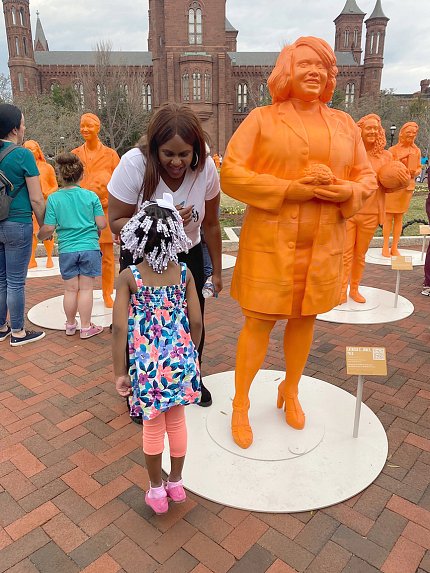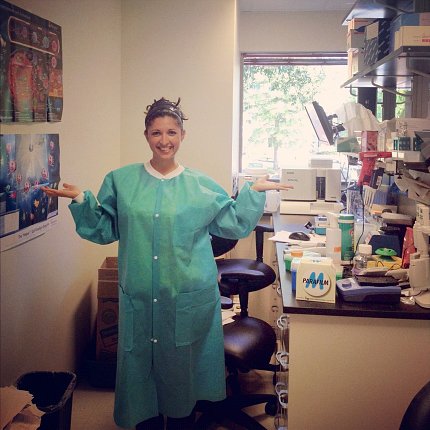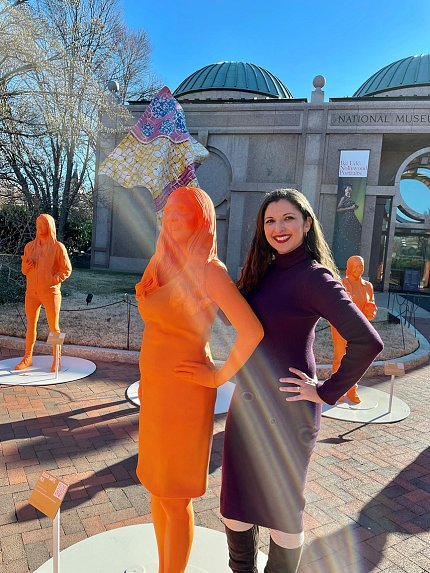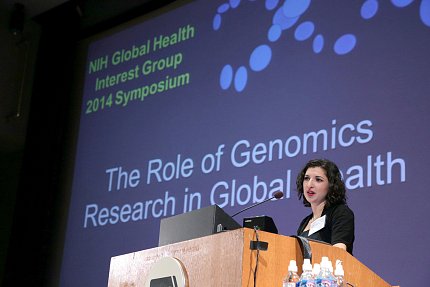STEM Ambassador
NINDS’s Jones Featured in Exhibit on Women in STEM

When Dr. Lataisia Jones, a scientific research officer in NINDS’s Scientific Review Branch, first began her science, technology, engineering and math (STEM) outreach efforts she never imagined her work would immortalize her as a life-size 3D-printed statue in an empowering exhibit. But that’s exactly what happened.
“I am still in disbelief that this little Black girl from Virginia who talked too much in her middle school science class could eventually serve as a global role model in STEM and have a statue placed at an exhibit down the street from the White House,” said Jones.
She is one of 120 STEM innovators featured in #IfThenSheCan—The Exhibit, which debuted at the Smithsonian in Washington, D.C., during Women’s History Month. The exhibit, which celebrates contemporary women leaders from a variety of STEM fields, is the largest collection of statues of women ever assembled together.
“The most memorable part of the opening weekend was being able to engage with the public and encouraging young girls and even the adults to pursue STEM careers regardless of barriers and challenges,” Jones said. “I especially felt joy from the kids who ran up to my statue, asked me about the brain and told me what they were learning in school. I kept things exciting by having them wiggle or dance to explore the mind-body connection and learn how neuroscientists study that connection.”

Photo: Marguerite Matthews
#IfThenSheCan is part of a larger effort—the Lyda Hill Philanthropies’ (LHP) IF/THEN Initiative—designed to inspire young girls to STEM careers. LHP partnered with the American Association for the Advancement of Science (AAAS) to select and manage the AAAS IF/THEN Ambassadors program, which engages high-profile STEM role models to spark STEM excitement among middle school girls. The exhibit features life-size versions of the ambassadors.
Jones became involved in 2019 when she was looking to start her own STEM outreach activities. She found an advertisement for the IF/THEN initiative and immediately applied.
“At the time, it was advertised as a funding opportunity to support STEM outreach programs created by women in STEM,” she recalled. “It wasn’t until our first weekend of workshops, receptions and meetings that we learned about the amazing opportunity of being featured as full statues.
“The project and exhibit provide a powerful message to girls everywhere that they can be whatever they want. Seeing the statues at the Smithsonian is a bold way of shifting the culture to accept and establish normalcy behind women in STEM careers. LHP and AAAS have taken on this courageous task of exposing middle school girls to their STEM potential. As a result, so many others have been positively influenced by this initiative.”
Jones earned her bachelor’s and master’s, both in science, at Virginia State University.
“I fell in love with the laboratory setting and being able to answer questions that would advance the field of cancer through experimentation and literature review,” she explained. “This was also the first time I ever met a woman who led her own laboratory.”
As an undergraduate, she traveled to Ghana where she taught science, English and math. Her work there ignited her passion for exposing youth to STEM topics and careers. She decided to earn her Ph.D. to make her outreach goals more achievable with a supportive network and additional science training.

Photo: IF/THEN®
In 2017, Jones became the first African American to earn a Ph.D. in the department of biomedical sciences at Florida State University.
She completed her postdoctoral research at the Center for Neuroscience Research at Children’s National Hospital in D.C., where her work focused on the involvement of plexins in corpus callosum development and their association with autism spectrum disorders.
As a graduate student, Jones studied a debilitating, involuntary movement disorder called levodopa responsive dystonia and developed an antibody that improves diagnostics.
“In my role at Children’s National Hospital, I created ‘Young Scientist Wednesdays,’ which provided patients with weekly STEM engagement and exposure to diverse leaders who taught them how to extract DNA from strawberries, the science between centrifugation while making pottery and even helped them explore the inside of the brain using augmented reality,” Jones said.
For safety reasons, the program was shut down during the pandemic. Luckily, she came up with another option—Kitchen Science with Dr. Tay—a YouTube show that explores STEM topics using live experiments with materials found at home. This virtual engagement has gained increasing interest and evolved into collaborations with several other organizations and STEM leaders.
Jones also volunteers as a writer and program host for the Association for Women in Science and serves as a national mentor and keynote speaker promoting STEM resources, programs and careers. She has earned numerous awards for her education efforts and advocacy for STEM diversity.
“I often reflect on constantly being the only Black woman sitting at the table,” said Jones. “It takes a lot to stay motivated in careers that lack diversity when you are unable to visually see representation in those spaces. Nevertheless, I encourage everyone to understand that if that one person (whether it is you or someone else) doesn’t take that journey alone and lift others while there, change may never occur.”




